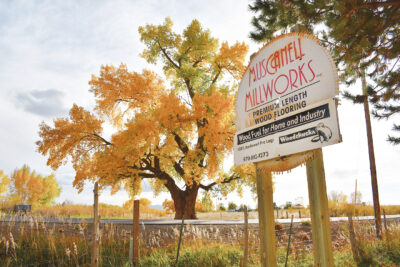Ontario
As we head into the Holiday Season, there is the usual slowdown in logging activities and sawmill output. Mill output, it was reported, had increased compared to the previous year. Demand for hardwood finished goods has shifted to a moderated level. The gains in production were evident, and demand on the domestic front softened along with international demand, which brought prices down sharply and quickly this year. The changes experienced in the hardwood sector has been hard on businesses. Inflation has pushed the costs of all goods and services higher. Contacts commented they are optimistic inflation will go down heading into the new year.
Ash demand continued to be moderate as the Emerald Ash Borer affected supplies of timber and log availability. Some noted Ash production had risen, especially in the U.S. border states, while demand had softened. Prices had decreased over the past few months. Some said kiln-dried markets weren’t as strong now as in 2021 and earlier this year, but inventories have increased.
Basswood appears to be doing better than many other key species. Some non-traditional markets that bought Basswood as a lower priced alternative to Poplar have decreased their use of this species. However, suppliers noted they’ve been shipping regular volumes to their traditional customers. Sales orders heated up from previous oversold levels and transactions point out varied lower pricing. Prices have gone down for certain grades. Green Basswood lumber production is meeting demand for most grades and thicknesses, noted contacts.
Demand of Birch finished goods decreased but end users said they were still busy filling existing orders. Cabinet manufacturers were feeling the pinch as the slowdown of completing homes under construction was holding back demand and fulfillment of some business for them. This slowdown affected Birch, Hard and Soft Maple sales. Millwork and moulding producers were also seeing similar challenges. Secondary manufacturers and lumber wholesalers said they were being more cautious with their purchases. Kiln-dried prices softened slightly, they commented.
Sawmill production of Hard Maple continues to be steady, with availability outpacing demand, which was reported as having declined and buyers were controlling their purchases. They were buying for short term or immediate needs. Wholesalers are struggling to keep production and inventories turning over, resulting in lower prices for some kiln-dried items.
Soft Maple was not a good seller for some areas contacted recently, compared to it being the best seller item only a few months ago. Availability is better but demand is weaker from most buyers and end users. End users are reluctant to buy more lumber currently as they have ample supplies on hand, and as prices are declining, are not purchasing more than needed for the short term. Mills that process kiln-dried lumber have large inventories. Lack of storage space and cash are causing stiff competition for orders, thus impacting kiln-dried prices.
Demand from export markets has waned for Red Oak. Canadian and U.S. business is better than international markets, although end users are not buying as much either. Inventories are high compared to buyers’ needs, with prices going down. Sawmills are having difficulty moving production.
White Oak continues to see high demand, especially for high end finished goods. Demand, here too, has softened due to both weaker domestic and export market demand.
The Bank of Canada governor Tiff Macklem said in October more interest rate hikes are necessary to bring inflation down, despite some early signs of a slowing economy. Speaking to the Halifax Chamber of Commerce earlier that month, Macklem said high inflation increasingly reflects domestic pressures on prices.
The governor said while global events such as the pandemic and the Russian invasion of Ukraine have fed into higher prices, demand is outpacing supply more broadly in the Canadian economy. He said, in hindsight, the bank’s early assessment that high inflation was temporary was “overly optimistic.”
As the economy fully reopened in the spring, pent-up demand for services in travel and recreation began driving inflation even higher, he said. Canadians experienced these pressures first-hand with travel bookings or reserving at their favourite restaurant.
After inflation reached an annual rate of 8.1 percent in June, the pace of price increases in Canada has since slowed, largely due to lower gas prices. In August, the annual inflation rate was 7.0 percent. However, Macklem said the core measures of inflation “have yet to decline meaningfully” even as headline inflation has come down.
As the Bank of Canada monitors inflation and the effects of higher interest rates, the governor said it will be paying close attention to its core measures of inflation, which tend to be less volatile than the overall inflation rate.
Macklem said there are some signs that global inflationary forces are easing, and that food inflation should soon begin to come down.
Despite prices for goods and services falling and global supply chains easing, though, these developments are not enough to bring inflation down, he said.
With labor markets still tight, the economy still in “excess demand” and inflation still too high, Macklem said more interest rate hikes will be necessary.
The central bank has been monitoring inflation expectations among people and businesses over concern inflation could become “entrenched.” High inflation expectations can lead to businesses setting future prices even higher and workers demanding higher wages in future wage contracts.
Macklem said to keep inflation expectations in control, “Canadians will need to see inflation clearly coming down.” There is more to be done, he said. At the time of this writing, the bank was set to make its next interest rate announcement on October 26. Since March, the central bank has raised its key interest rate from 0.25 percent to 3.25 percent, one of the fastest rate hike cycles in its history. Macklem said high inflation hurts people and business by creating “uncertainty and unfairness” and distorting decision making and undermining confidence.
Let’s hope that more will be done and that the hardwood sector can see some relief in the coming year. Wishing everyone the best of the Holiday Season and a Happy New Year!
Quebec
As we head into the Holiday season, and with the U.S. Thanksgiving holiday over, businesses are cautiously optimistic the new year will bring relief from inflation, and that hardwood demand will improve as prices stabilize, along with seeing improvements in economic conditions and ongoing supply chain issues get resolved. The challenge is to reduce costs for all who are involved in the hardwood sector, from loggers to sawmills to secondary manufacturers and of finished goods.
Depending on areas contacted, producers and resellers of the regionally important Hard Maple say market conditions are different than earlier this year. While some were unable to fill all available orders, others are having a hard time moving all their production. It was noted that kiln-dried inventories of Hard Maple had risen in the fall despite price reductions. With prices dropping, their customers hesitated placing orders unless necessary. It was noted that the price decrease was smaller more recently.
Demand for Soft Maple is not great. As new home construction has slowed down both in Canada and the U.S., this has impacted Soft Maple demand, as it has for other species. Prices are trending down as a result.
Basswood saw a competitive market atmosphere during early fall. Kiln-dried demand was slower and production was steady and so some contacts had more inventory and some were lowering prices to generate sales.
Cherry is not seeing great performance, as was the case in the past on all market fronts. This species does not seem to be part of the trend at this time in North America as many cabinet, millwork, furniture and wood component plants purchased small volumes of this species. These sectors have reduced their purchasing as they, too, have had reduced order files. The same is said for shipments to overseas markets, noted contacts. As a result, supply is exceeding demand, and thus prices are affected.
Hickory demand is based on a replacement basis for many buyers at this time. Therefore, prices are edging lower. Domestic and international markets have abundant supplies of this species. Sawmills are able to meet production demand for green Hickory.
The Number 2A and 3A Red Oak and White Oak prices held steady in mid-October, ending the long weekly decline of prices for this species. Residential wood and truck trailer flooring manufacturers are still controlling purchases of these two species for these grades, but some were said to have stopped lowering prices or slowed the rate of decreases.
Red Oak sales are hard to come by due to unfavorable trends in some important markets which is negatively affecting demand for Red Oak. The largest export market for Red Oak, China, does not have a strong economy at the moment, due in part to lockdowns caused by COVID and the potential for more. Buyers there are being very price conscious when placing orders. The other factor is the residential wood flooring manufacturers who are reducing their purchases of this species due to slow business, and also consumer interest is more for White Oak than Red Oak flooring. As well, truck trailer flooring companies have ample lumber for their needs. Red Oak also only has a small share of the cabinet, furniture, moulding and millwork markets. Contacts noted prices were softening as well for most green and kiln-dried items.
As for White Oak demand, it has also waned in markets, and so supply and demand are not balanced, resulting in price pressures. Poplar demand, which was very popular until recently, is now one of the worst sellers, noted some contacts. Although domestic end users are still purchasing this species, many have reduced the amount purchased. Demand from Europe and Southeast Asia are reported to be down as well.
According to Royal Bank of Canada’s (RBC) Monthly Housing Outlook, Canada’s housing market’s downturn has longer to run. September data gave few indications the bottom is near. Both activity and prices continued to trend lower in the vast majority of local markets. Demand-supply conditions generally eased some more. And with further interest rate hikes likely on the way, RBC expects more of the same in the period ahead across the country. That said, activity in Ontario and British Columbia may be closer to stabilizing (though not so much for prices due to persisting affordability issues).
September marked the seventh-straight monthly decline in home resales in Canada (down 3.9 percent). This puts the correction at -36 percent since February. While Prince Edward Island (-10.8 percent), Nova Scotia (-8.1 percent) and Manitoba (-6.6 percent) saw the largest drop in September, it’s been British Columbia (-47 percent), Ontario (-41 percent) and Alberta (-41 percent) that fell the most in the past seven months. Activity is now below pre-pandemic levels in all provinces except Alberta, Saskatchewan, and Newfoundland and Labrador. Home resales in Canada (at 419,900 units on a seasonally adjusted and annualized basis) are the softest in a decade and likely to stay that way for a while longer.
Property values similarly have declined in each of the last seven months nationwide since September and in most of Ontario (including Toronto), and the past six months in key British Columbia markets (including Vancouver). Canada’s composite MLS Home Price Index fell 1.4 percent month/month (m/m) in September, and is now down 8.8 percent since the February peak. Leading the price correction have been smaller markets in Ontario that saw tremendous appreciation earlier during the pandemic: Cambridge (-20 percent), Kitchener-Waterloo (-18 percent), Brantford (-16 percent), London (-16 percent) and Hamilton (-16 percent). Chilliwack (-13 percent) and the Fraser Valley (-11 percent) in British Columbia also recorded outsized declines since the peak.
Prices in larger markets are down significantly too—just not quite as much, adds RBC. Toronto’s MLS HPI has declined 9.2 percent (or $118,000) since February, including a 1 percent drop in September. The correction ranks as the second largest in the area since the inception of the index in 2000 and is rapidly closing in on the downturn that took place in 2017-2019 (-10.9 percent). Vancouver’s index is off 5.7 percent (or $71,000) since March. RBC thinks it has much further to go given the intense unaffordability pressures currently in place. Their latest Housing Trends and Affordability report noted Vancouver buyers face the highest ever ownership costs anywhere in the country. Falling prices are a more recent phenomenon in Montreal where the MLS HPI crested in May. The correction is picking up steam, though. September saw the biggest drop (-1.7 percent m/m) so far, deepening the downturn to -4.7 percent (or -$25,600).
RBC expects home resale activity to stay quiet in the coming months across the country. The sharp interest rate increases to date and likelihood of additional hikes in the coming months—RBC anticipate the Bank of Canada will take its policy rate deeper into restrictive territory to 4 percent by December—will continue to hold back buyers. They see this depressing demand further though some markets may have more limited room to fall. They think resales have plummeted to such low levels in many areas of British Columbia and Ontario that they will soon reach a floor.
Rising rates will intensify affordability issues in the near term and sustain heavy downward pressure on home prices. RBC expects benchmark prices will fall approximately 14 percent nationwide by next spring from the recent peak, with steeper declines (-16 percent) in Ontario and British Columbia, and milder corrections in Alberta and Saskatchewan (-4 percent).









